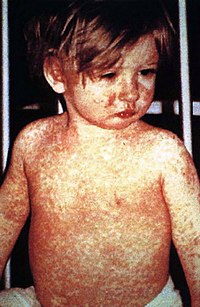
Photo from wikipedia
OBJECTIVES To describe the most common ocular lesions and demonstrate the frequency of ophthalmic involvement in a group of cats with systemic sporotrichosis. ANIMALS STUDIED Two hundred seventy-four cats diagnosed… Click to show full abstract
OBJECTIVES To describe the most common ocular lesions and demonstrate the frequency of ophthalmic involvement in a group of cats with systemic sporotrichosis. ANIMALS STUDIED Two hundred seventy-four cats diagnosed with systemic sporotrichosis. The inclusion criteria included previous positive cytopathological examination, histopathological examination, or fungal culture. PROCEDURES In a prospective case-control study, 274 cats diagnosed with systemic sporotrichosis underwent ophthalmic evaluation and received treatment for systemic sporotrichosis. Of these animals, 63 had ocular abnormalities which were recorded, and conjunctivitis was scored from 0 to 5. Diagnostic techniques utilized included fungal culture, as well as cytopathological (10 eyes; 10 cats), and histopathological examination of the palpebral conjunctiva and eyes (2 eyes). RESULTS Cytopathological and histopathological examination of the conjunctiva, as well as fungal culture, proved to be important tests for the detection of Sporothrix sp. Five cats without the evidence of ophthalmic abnormalities also had a positive fungal culture. The identified ocular lesions in animals with systemic sporotrichosis included increased serous discharge (79 eyes; 53 cats), blepharoconjunctivitis (33 eyes; 25 cats), conjunctivitis (39 eyes, 20 cats), blepharitis (9 eyes; 8 cats), uveitis (5 eyes; 3 cats), and Florida keratopathy-like lesions (2 eyes; 1 cat). CONCLUSION Sporotrichosis should be considered a differential diagnosis for conjunctivitis and blepharoconjunctivitis, especially in endemic areas. Fungal culture and cytopathology of ocular discharge and histopathological examinations of the conjunctiva are important for the diagnosis of ophthalmic sporotrichosis, although not all cats underwent laboratory testing in this study. Ocular discharge could be a source of contagion transmission.
Journal Title: Veterinary ophthalmology
Year Published: 2022
Link to full text (if available)
Share on Social Media: Sign Up to like & get
recommendations!